Alleviation: An International Journal of Nutrition, Gender & Social Development, ISSN 2348-9340
Volume 7, Number 7 (2020): 1-11
© Arya PG College (College with Potential for Excellence Status by UGC) & Business Press India Publication, Delhi
http://apcjournals.com, www.aryapgcollege.com
Old Age Problems and Effect on Kitchen Activities
Swarn Lata 1 and Razia Parvez 2
1MSc Student and 2 Head
Department of Family Resource Management and Consumer Science
Sam Higginbottom University of Agriculture, Technology and Sciences (SHUATS) , Allahabad
(Uttar Pradesh), India
Email: swrnlata59@gmail.com
Abstract
A man’s life is normally divided into five main stages namely infancy, childhood, adolescence, adulthood and old age, in each of these stages an individual has to find himself in different situations and face different problems. Kitchen is the most important space in a house. A larger kitchen size will increase a number of footsteps and energy expenditure. This will also demand extra time consuming for tiding up and maintaining the cleanliness besides the main function for meal preparation. The height of kitchen units is one of the major ergonomic problems that can affect task performance in kitchen. The objective of the study was to find out the existing kitchen designs in the homes of the selected respondents who were suffering with lower limb difficulties. Eighty elderly (M=40, F=40) participated in the study and their homes were visited. They are aged between 60-65 years, 65-70 years and 70-75 years. A set of interview schedule was designed to measure daily time spending, ability to cook in standing kitchen, incidences of injuries in the kitchen and also problems related to lower limbs in elderly age. The design and dimensions of each kitchen size were measured with measuring tape. Data were analyzed using percentages and averages. It was found that the work environment in a majority of these kitchen units was unsafe and not completely user friendly for elderly with lower limb difficulties. Therefore need of the elderly suggested to have shorter kitchen work triangle.
Keywords: Elderly People, Lower Limbs, Daily Time Spending, Level of Tiredness, Kitchen Design.
Introduction
Old age is the closing period in the life span of an individual. It is the period when people "move away" from previous, more desirable periods or time of usefulness" As people move away from the earlier periods of their life, they often look back on them, usually regretfully and tend to live in the present, ignoring the future as much as possible. The age of sixty is usually considered the dividing line between middle and old age. However, it is recognized that chronological age is a poor criterion to use in marking off the beginning of old age because there are such marked difference among individuals in the age at which aging actually begins. The last stage in the life span is frequently sub- divided into early old age, which extend from the age of sixty to seventy years and extend to the end of life. Although internal changes are not as readily observable as external ones, they are nevertheless as pronounced and as widespread. Changes in the skeleton are due to hardening of the bones, deposits of mineral salts and modifications of the internal structure of the bones. As a result of these changes, bones become brittle and are subject for fractures and breaks, which are increasingly slow to heal as age progresses. Strength and ability to work decrease as muscular flabbiness and general weakness make it more difficult for old people to use their muscles. The ability to do strenuous work for a short period of time diminishes with age while the ability to withstand a long steady grind increases. Most old people are aware that they move slowly and are less well coordinated in movements than they were when they were younger. These changes in motor abilities are partly due to physical causes and partly due to psychological causes, some health problems and common ailments that generally affect the elders, like joint pain. In the old age, arthritis problem is more common, the meaning of arthritis is 'inflammation of the joints'. The word rheumatism is even more general and is used to describe the aches and pain in joints. The symptoms include pain, swelling and stiffness with limitation of joint movements. A kitchen is part of a house which is multipurpose in character. Kitchen is the most used space in a home. In a kitchen, cooking may be done either by males or females, or by youngsters or elders. So kitchen needs to provide a particular space for every item, where a person can easily prepare the food. Falls are common among the elderly and although such accidents can occur in any room in the house, they seem to happen more often in the kitchen area. Failing memory, poor vision and poor balance can increase the risk for injury, just bending over to reach for items in low cupboards sometimes cause an older individual to lose his or her balance.
A man’s life is normally divided into five main stages namely infancy, childhood, adolescence, adulthood and old age, in each of these stages an individual has to find himself in different situations and face different problems. In old age, physical strength deteriorates, mental stability diminishes and money power becomes bleak coupled with negligence from younger generation. Some children want to help and stay with their parents but they are living outside the home for their job purposes, so they are unable to do so. Changes in skeleton are due to hardening of the bones, deposits of mineral salt and modification of the internal structure of the bones. As a result of these changes, bones become brittle and are subject to fractures and breaks, which are increasingly slow to heal as age progresses. Therefore, after getting old, they need suitable environment for each work because they cannot stand for a longer period of time in cooking area and also they cannot sit longer for any home work especially when they are facing problems in their lower limb. Even if elders have sufficient money to keep a servant, some of the elders do not like food cooked by servants and they want to cook the food by themselves. The present study was undertaken to find out the existing kitchen designs in the homes of the selected respondents who were suffering with lower limb difficulties.
Materials and Methods
The present study was conducted in the Trans Yamuna areas of Allahabad. The data were collected from elderly males and females between the of age of 60 – 75 years. The six villages selected were “Mahewa”, “Gangotri Nagar”, “Dandi”, “Ganjia”, “Maduka”. The sample size selected for the study was 80 which consisted of 40 elderly males and 40 elderly females. The kitchen dimension were measured with measuring tape. The interview schedule was used for data collection. The samples selected were on the basis of elderly who were facing lower limb problems like arthritis problems and occupational hazards in kitchen activities. Anthropometric measurements were taken in relation to kitchen dimensions. The data were analyzed with frequency and percentages and body map was used to identify the location of pain in the body parts. The elderly were personally contacted and motivated to share their problems and experiences after explaining the objective of the study.
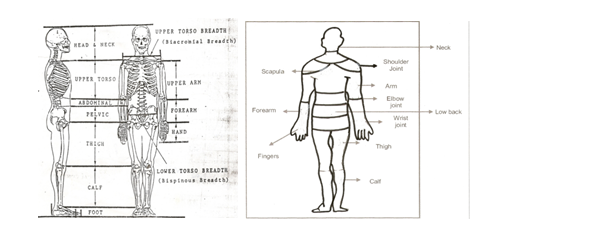
Results and Discussion
The results of the present research in accordance with the objectives, derived through the use of required methodology and standard tools have been presented in this chapter. Following are the main heads under which the research results have been presented and discussed.
Background Information of Elderly Males and Females
Table 1 shows the distribution of elderly males and elderly females according to their age, educational qualification, family size, type of family and their income.
It was found that majority (65 %) of elderly males and 90 per cent of elderly females were in the age group of 60-70 years, whereas 25 per cent elderly males and 10 per cent elderly females were between the age group of 60-65 years. Only 10 per cent elderly males fell between the age groups of 70-75 years. It was also recorded that 65 per cent of elderly males and 37 per cent elderly females were educated up to graduation level, 52 per cent elderly females and 22.5 per cent elderly males had studied up to intermediate whereas 7.5 percent elderly males and elderly females were high school and 2.5 per cent elderly males and elderly females were educated up to post graduation. It is surprising to note that cent per cent elderly males and elderly females had small family size and fell under the category of nuclear family. As far as income of the family is concerned, majority of the elderly males and elderly females were under the category of both daily and monthly income, least percentage was under daily wage category and no one was under weekly wages category.

Marital Status
Table 2 presented below shows the distribution of elderly males and elderly females according to their marital status. It was found that 97.5 per cent of elderly males and 80 per cent of elderly females were married whereas 2.5 per cent elderly males and 5 per cent elderly females were widowers and 12.5 per cent elderly females were divorcees.

Occupation
Table 3 presented below shows the distribution of elderly males and elderly females according to their occupation.
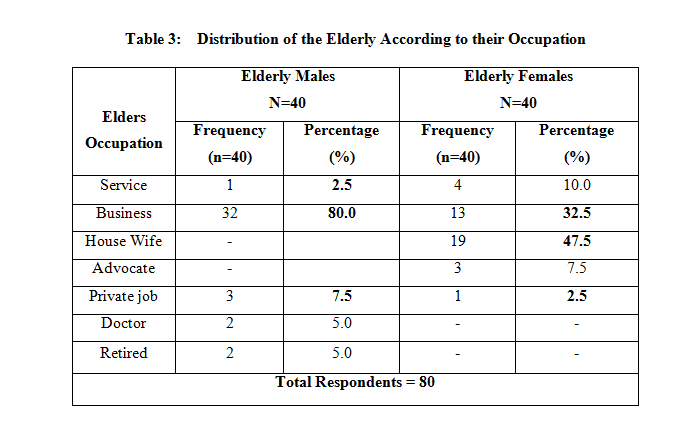
The data reveals that the majority (80 %) of elderly males and 32.5 per cent of elderly females had their own business and 47.5 per cent elderly females were purely house wives, 7.5 percent elderly males and 2.5 per cent elderly females were in private jobs whereas 2.5 per cent elderly males were in service.
Information Regarding the Problems of Elderly in Lower Limbs
Table 4 presented below shows the distribution of elderly males and elderly females according to their incidences of pain in their legs.
It can be seen that majority (60 %) of elderly males and 30 per cent elderly females were facing the problem of pain in lower part of their knee in heal and finger joints and 40 per cent elderly females and 15 percent elderly males had problems in their whole legs, whereas 15 per cent elderly males had knee pain and 7.5 per cent elderly males and 17.5 per cent elderly females had pain in their thighs. Therefore, it is concluded that both elderly males and females faced pain in their legs frequently.
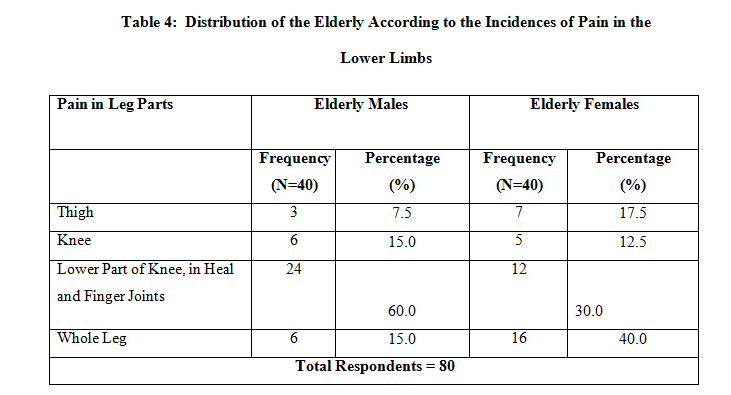
Working Capacity
Table 5 presented below shows the physical problems in elderly males and elderly females.
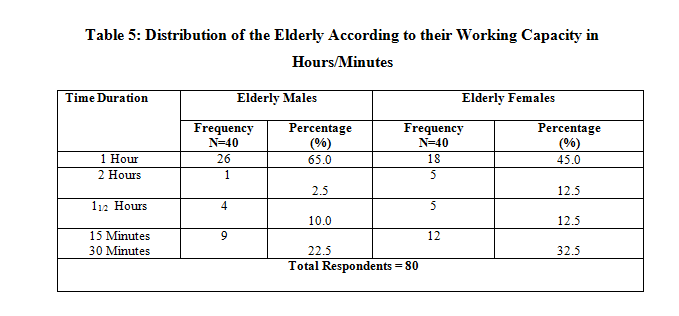
Majority of elderly males (65%) and 45 per cent of females used to work in the kitchen for one hour whereas 22.5 per cent and 32.5 per cent elderly males and females used to work for 15 minutes to 30 minutes. Only 2.5 per cent and 12.5 per cent of elderly males and females respectively were able to work for 2 hours. So, it is concluded that elderly males and females used to get tired after 1 hour of continuous working in standing position.
Problems in Old Age
Table 6 presented below shows the physical problems in elderly males and elderly females.
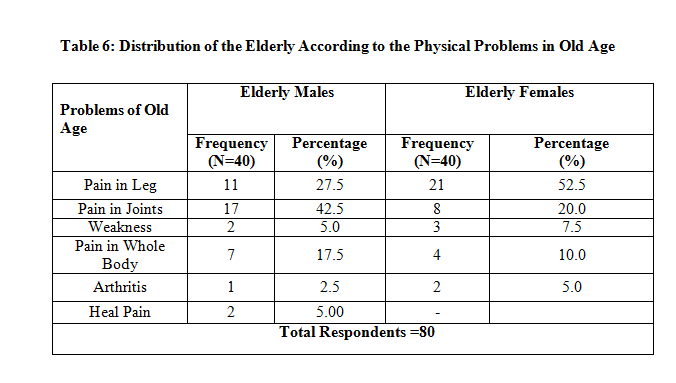
It can be seen that 52.5 per cent of elderly males and 27.5 per cent of elderly females felt pain in joints, 2.5 per cent elderly males and 5 per cent elderly females reported arthritis problem. With the consultation of doctor, it was detected that the pain in leg and joints is the prime symptom of starting of arthritis problem.
Ability to Work in Standing Kitchen
Table 7 presented below shows the ability of cooking in standing kitchen of elderly males and females.
It was found that 77.5 per cent of elderly males and 60 per cent of elderly females were able to cook standing in the kitchen whereas 22.5 per cent and 40 per cent elderly males and female respectively were not able to work standing in the kitchen due to severe pain in their legs.
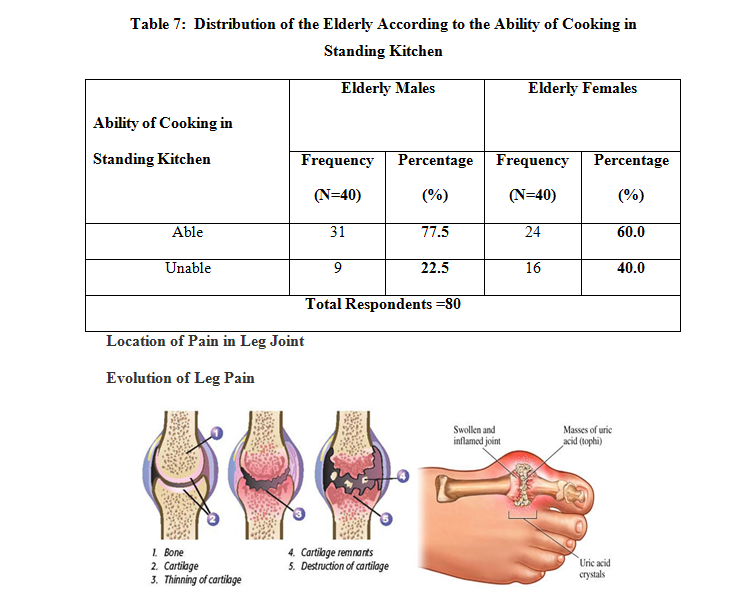

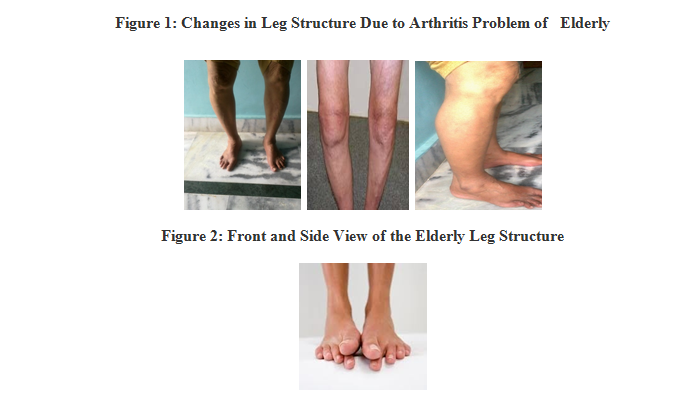
Information Regarding Existing Kitchen Design
Table 8 presented below shows the existing kitchen shapes observed in elders’ homes.
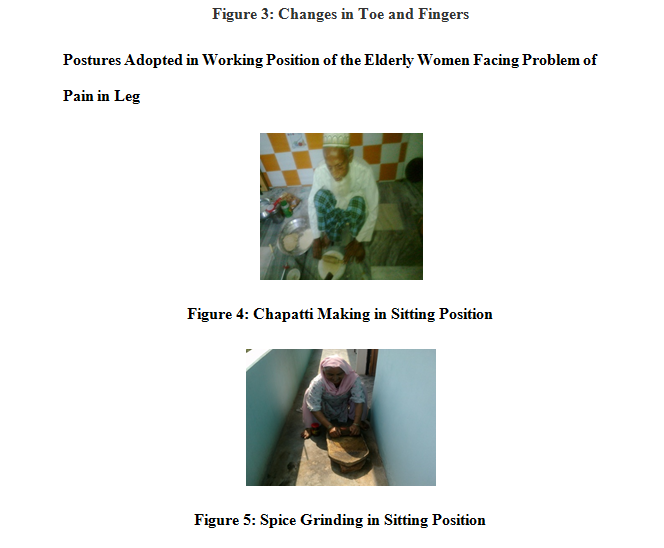
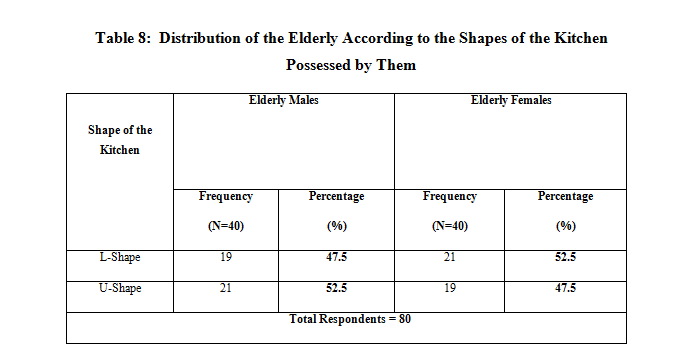
It can be seen that maximum percentage (47 %) of elderly males and 52.5.per cent of elderly females had L-shaped kitchen whereas 21 per cent of elderly males and 47.5 per cent of elderly females had U-shaped kitchen.
Existing Kitchen Design Layout of U-Shaped Kitchen
On the basis of information obtained on existing kitchen designs, the layouts of L- shaped kitchen and U-shaped kitchen were selected and drawn on AUTO- CAD.

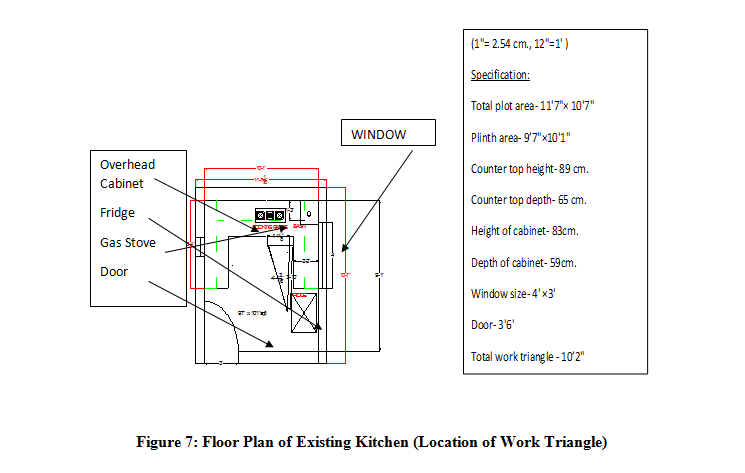


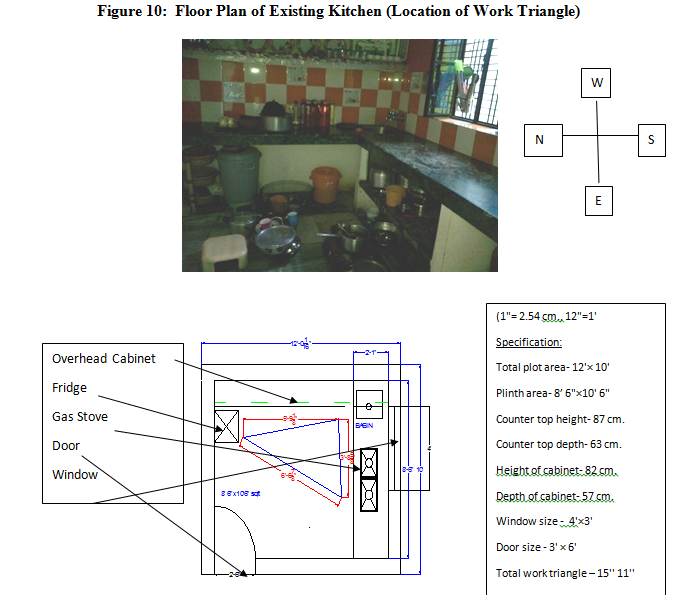
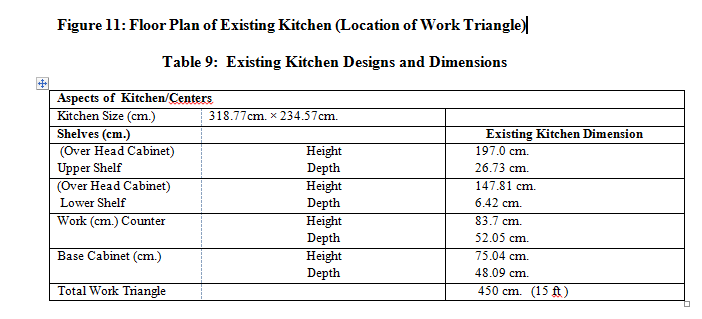
All the dimensions of existing kitchen were measured and recorded for data collection. Table 9 shows that the height of upper shelf was 147.81 cm. and depth was 26.42 cm. Work height of the counter top was 83.7 cm. whereas depth was 50.05 cm. The height of base cabinet was 75.04 cm. and depth was 48.09 cm. The total triangle was 450 cm.
Conclusion
It was found that the work environment in majority of these kitchen units was unsafe and not completely user friendly for elderly with lower limb difficulties. Therefore need of the elderly suggested to have shorter kitchen work triangle with adopted postures. And they possibly will save their happy full life with daily kitchen activities
References
Conra T (2002) Kitchen: The Hub of the Home. London: Octopus Publishing Groups: 70.
Chanana HB and Talwar PP (2000) Ageing in India: Its Socio Economic and Health Implications. Journal of Asia-Pacific Population 2 (3): 23-38.
Hurlock EB (2003) Developmental Psychology. New Delhi: Tata Mc.Graw-Hill book Co.Inc: 390-391.
Neil C (2008) Ageing and Human Performance. Journal of Ageing and Human Factor 50 (.3): 548-555.
Sturnieks DL, Tiedemann A, Chapman K, Munro B, Murray, SM, Lord and SR (2004) Physiological Risk Factors for Falls in Older People with Lower Limb Arthritis. Journal of Rheumatology 31(11): 2272-2279.
Thomas E, Peat G, Harris L, Wilkie R and Croft R P (2004) The Prevalence of Pain and Pain Interference in a General Population of Older Adults. PubMed 110: 361-368.

